 Extended Budgeting
Extended Budgeting



This chapter discusses the Extended Budgeting module, including appropriation and allotment programs, program budget units, expense budgets, and revenue budgets.
The chapter covers the following topics:
The MARS Extended Budgeting module does not require users to adapt to any particular budgetary method or concept. MARS can be used to perform standard line item budgeting, cost accounting budgeting, zero-based budgeting, and program isolation, as well as combinations of these methods.
Budgetary information can be collected for entry into MARS via documents or turnaround reports. This information is then entered into MARS ADVANTAGE through the following documents or through MARS BRASS which will create these documents in MARS ADVANTAGE. Depending on the type of budgetary activity, users would process one of the following transactions to enter or modify MARS budget data:
Budgetary data is recorded in MARS in several system-maintained application tables as well as in two budget ledgers. That is, whenever a budget transaction is processed, the system automatically updates the appropriate budget windows to reflect the activity and posts transactions to ledgers to provide a detail audit history of the activity. Tables and ledgers relevant to the budget module include:
The following terms are used throughout this chapter:
MARS distinguishes between the accounting fiscal year and the budget fiscal year, allowing accounting transactions to be posted to different accounting and budget fiscal years.
Budget Fiscal Year and Accounting Fiscal Year
This allows transactions which were budgeted in a prior budget fiscal year but not transacted until a subsequent accounting fiscal year to be applied against the correct budget.
This situation occurs, for instance, when a purchase order issued in one fiscal year is cleared by a payment voucher posted the following fiscal year or when spending against a continuing appropriation takes place in succeeding years. See Expenditure Accounting for a detailed explanation of these transactions.
For other accounting transactions to reference a different budget fiscal year, the budget fiscal year must be entered on the document and the fiscal year must be open. The transaction is subject to the budgeting constraints which were in effect for that fiscal year. Usually, however, the budget fiscal year and the accounting fiscal year will be the same, and the budget fiscal year will not need to be entered on the accounting document. If the budget fiscal year is not entered on the accounting document, the budget fiscal year associated with the transaction date is assumed.
The budget fiscal year is required on all budget transactions. The Budget Fiscal Year entered must exist in Fiscal Year (FSYR), and it must be open. It may be the previous year (if still open), the current year, or a future year.
A future budget fiscal year is permitted so that an entire budget (expense, revenue, appropriations, and allotments) can be entered, modified, and approved before the fiscal year has actually begun. Budget preparation transactions for a future year in no way affect the current year budget or current year accounting.
Grants and other special projects often have budgets that span fiscal years. MARS provides the primary methods for handling multi-year budgeting. One method is for grant budgets to be established such that they span fiscal years. This is accomplished in MARS by selecting the Appropriation Type Continuing and recording the relevant grant expiration date as the appropriation end date. MARS will automatically set the Multi-Year indicator on such appropriations , thereby flagging the appropriation as multi-year. When the Multi-Year indicator is selected for Appropriation Type Continuing , the budget line is valid for the life of the grant (as defined by the Appropriation End Date ), instead of for a single budget fiscal year. The budgeted amount should represent the total grant budget. At year-end, the multi-year budget lines are not affected.
When accounting and budget transactions reference multi-year appropriations, the Fund , Agency , Organization , Activity , Function , Object , and Revenue Source codes on the window are validated against the current fiscal year entries in the respective master tables.
Another method for handling grant budgets on a multi-year basis is available through Project Billing. Under this method, budgets that span the life of the grant may be established and maintained separately from the appropriation budget structure.
Entering Amounts on Budget Transactions
All amounts entered in the system on budget transactions must be whole dollars only. Cents must not be entered, even as zeros. The budgetary transaction processors ignore a decimal point if one is entered.
For example, $25 as a budgetary amount must be entered as 25 . If 25.00 is entered, the decimal point is ignored and the zeros are interpreted as hundreds of dollars. The $25.00 would be stored in the system as 2500 .
- This is true for budgetary (and planning) amounts only. Amounts on accounting transactions must include cents.
When a budget is officially approved by a governing body, and when the officially approved figures agree with the amounts existing in the MARS budget tables (appropriation, expense budget, and revenue budget), the Budget Approved Indicator in Fiscal Year (FSYR) should be set to Y . This action permanently records in the system all budget amounts as originally approved by the governing body. These amounts are identified in the budget tables as the approved budgeted amount (versus the current modified amount). The approved budgeted amounts provide a base for tracking budget modifications.
Before the Budget Approved Indicator is set to Y , modifications to budgetary transactions affect both the approved budgeted amount and the current modified amount, and these two amounts remain the same. After the Budget Approved Indicator is set, budgetary modifications change only the current modified amount. All expenditure controls are governed by the current modified amount.
MARS provides a method for preparing a new year's budget based on the previous year's budget already stored in the system.
At year end, all of the previous year's budget lines can be automatically rolled into the new year, putting zeros in the pre-encumbrance, encumbrance, and expenditure fields. Users may then submit budget transactions to change the budgetary line amounts.
Turnaround reports are reports that can also be used as budget work papers. They list the current year's budget, line by line, with extra columns to allow changes to be written in by users.
Turnaround reports are helpful when preparing new budgets and for budget review cycles. These forms can be used as a data entry document to directly enter the budget transactions as if they were keying documents.
Appropriations (Appropriation Programs)
An appropriation is a dollar amount designated for a specific purpose by law. For example, your authorizing body may authorize a certain amount to be spent on parking lot improvements. In MARS, an appropriation refers to a set of expense budget lines, all governed by the same legislative authorization. You can, for example, establish an appropriation called parking lot improvements, which may be represented in your expense budget with three lines: new lot construction, widening and repaving, and routine maintenance (repairing potholes, repainting lines, etc.).
New appropriations are added to the system with an Appropriation (AP). They are stored in a system-maintained Appropriation (EAP2) table. The expense budget lines are linked to the appropriation through the Fund, Agency, Organization, and Appropriation coded on the expense budget line.
The steps necessary to implement the MARS appropriation capability are:
- Decide, for each fund, whether to institute Appropriation Full , Presence , or None on the Control Options view of Fund (FUN2). (See System Controls and Options.)
- Decide for each fund/agency whether the Appropriation Organization is Required on Budget and Accounting for this fund/agency. If this option is selected, the Appropriation Organization must be entered on appropriation lines. If the option is set to Required on Accounting , Organization is required on all accounting transactions, but cannot be entered on appropriation lines for the fund/agency. If the option is set to Optional on Accounting , Organization cannot be entered on the appropriation lines.
- Establish the Appropriation Program on the Program Reference Table (PRFT).
- Establish Appropriation Programs on Appropriation Inquiry (EAP2) through appropriation transactions. Appropriation amounts may be entered simultaneously or postponed to a future date.
- Optionally, build the expense budget or Program Budget Unit around the Appropriation Programs. It is especially important to think through the relationships between appropriations and budget lines for appropriations governing funds for which Full control is chosen.
An appropriation line written within a Fund, Agency, and, optionally, Organization is identified by an Appropriation Program code. Appropriation lines are established in the system via Appropriation (AP) transactions. Appropriation transactions can be entered without amounts so that new codes can be established in the system before actual amounts are available. Modifying documents increase or decrease previously recorded appropriation amounts as long as the budget fiscal year is still open.
Appropriations are established for an entire budget fiscal year and not for individual accounting periods. Appropriation transactions can be entered at any time during the budget fiscal year, and can also apply to a prior fiscal year as long as the year is still open. Annual closing prevents any further additions or modifications to single year appropriations for a closed year.
Appropriation transactions are also accepted for budget preparation years (future budget fiscal years). Figure 25 is a sample Appropriation (AP) document.
Appropriations and Organizations
The level of detail at which appropriations are established in MARS can vary widely. Appropriations can relate one-to-one with Object codes, specific organizations within a fund/agency, or an entire fund/agency.
If the Appropriation Organization option on Fund Agency (FGY2) is Required on Budget and Accounting , then Organization is required when defining the appropriations. If the option is set to Required on Accounting , Organization is required on all accounting transactions, but cannot be entered when defining appropriations. If the option is Optional on Accounting , then the Organization code cannot be entered on the appropriation lines.
Appropriations can only be established for organizations that are set up as Appropriation Organizations. To determine whether appropriations are controlled by is an appropriation organization, check the Fund Agency (FGY2) entry that corresponds to that fund and agency combination. The Organization options indicate whether the organization is required on the appropriation.
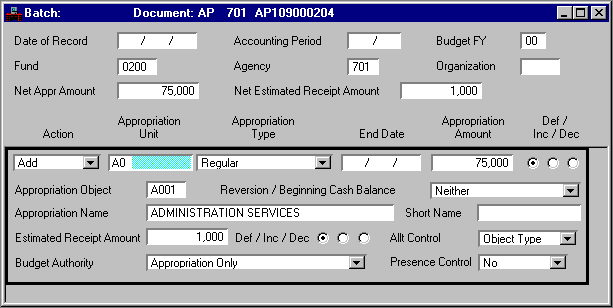
MARS provides the capability to identify appropriations by type. Valid selections for the Appropriation Type Appropriation (Extended) (AP) are identified below.
Appropriation End Date, Multi-Year Appropriation Indicator
Each appropriation must be assigned an End Date on the Appropriation (AP) document . The end date determines how long an appropriation is to be active. The majority of appropriations are based on fiscal year budgeting and will end at the end of the fiscal year.
Accounting transactions cannot reference an appropriation if the Date of Record is greater than the End Date on the Appropriation (AP) document . Transactions that do will be rejected.
The Multi-Year indicator on Appropriation Inquiry (Extended) (EAP2) is automatically selected if the appropriation's End Date is greater than the Fiscal Year/End Date (when the appropriation is established). Multi-Year appropriations must be assigned an Appropriation Type of Continuing on the Appropriation (AP) document.
You may decide to use appropriation amounts as controls on spending. This decision affects the appropriation transactions that you enter. The option to use appropriations as controls is chosen individually for each fund, and the choice for each fund is recorded on the Control Options view of Fund (FUN2), in the Appropriation Control field. Valid values for the field are:
- Full . Total obligations against appropriation program within the fund cannot exceed the budgeted authority amount. Therefore, you must enter appropriation transactions for the fund, including valid amounts. The value of the budgeted authority amount depends on the Budget Authority Option chosen for the Appropriation Program (see the relevant discussion below).
- Presence . The fund requires appropriation budgets, but amounts are not checked; therefore, you must enter appropriation transactions for the fund, but amounts can be zero.
- None . The fund does not use appropriation budgets; therefore, you cannot enter appropriation transactions for the fund. (Please note that this option should not be used for MARS).
As described above, the primary level of budgetary control chosen for appropriated programs is specified on Fund (FUN2). A secondary level of budgetary control can be specified for individual appropriated programs that supersedes the Appropriation Control options specified on FUN2. This secondary level allows for an appropriated program to be established with Presence budgetary control even though the primary budgetary control is full. The Use Presence Control option will allow specific Appropriated programs within a fund to be established with Presence Budgetary Control even though the Fund is established with Full Budgetary Control.
Appropriations and Expense Budgets
The relationship between appropriations and the expense budget can vary widely depending on the budgeting requirements of the organization. Appropriations will generally exist at a higher reporting level or the same level as the expense budget. The relationship between the units of appropriation and expense budget objects is established in Expense Budget Inquiry (Extended) (EEX2) with the Expense Budget (EB).
The sum of all expense budget line amounts using a particular Appropriation Unit can be viewed on Appropriation Inquiry (Extended) (EAP2) or can be generated by MARS standard reports. The total obligations and unobligated balances against appropriation budgets are also displayed on Appropriation Inquiry (Extended) (EAP2) or hard copy reports.
The Appropriation Object provides the ability to differentiate appropriation amounts for a variety of "types" of appropriations such as: Regular Appropriations, Appropriation Revisions Due to Reorganization, and Appropriation Revisions for Salary Improvements. Appropriation objects will be stored on Budget Object (BOBJ). Appropriation documents will validate that the Appropriation Object code is stored on BOBJ. The AP document validates against the Budget Object Indicator to ensure that the code is an Appropriation object. If the Budget Object Indicator does not identify the Budget Object as an Appropriation object (AP), then the system will issue an error message and will not process the AP transaction.
Encumbrance and Obligation Controls
The expenditure accounting document processors enforce Appropriation Full or Presence control. The account code structure of the transaction (i.e., Fund , Agency , Organization , and Appropriation ) points to a specific expense budget line and its corresponding appropriation budget line. MARS first checks the transaction against the expense budget controls. If the transaction passes those budgetary controls, MARS then looks up the appropriation budget line in the appropriation table based on the account code structure entered on the transaction.
If Appropriation Presence control is in effect, the existence of a line in the appropriation table that matches the transaction Appropriation code is enough to satisfy the edit. If Full control is in effect, the potential obligation recorded on the transaction and the current obligations against the appropriation must not be greater than the budget authority amount. If it is, the transaction is rejected.
When appropriations are used as limits to expenditures ( Full Appropriation control), careful thought should be given to the set of expense budget lines to be governed by each appropriation budget.
The Budget Authority Option, located on Appropriation Inquiry (Extended) (EAP2), defines the budgeted authority amount used as the limit on obligations when the Appropriation Control Option on Fund (FUN2) is Full . The Budget Authority Option is chosen for each appropriation account, and is recorded on the Appropriation document (AP). Valid budget authority option values are:
- Appropriation Only . This means that the budgeted authority for the appropriation program is the appropriation amount. You need to enter the appropriation amount on the appropriation transaction window.
- Actual Receipts . This means that the budgeted authority for the appropriation program is the appropriation program amount plus actual receipts against the appropriation. You need to enter the appropriation amount on the appropriation transaction window.
- Estimated Receipts . This means that the budgeted authority for the appropriation program is the appropriation amount plus estimated receipts against the appropriation. You need to enter the appropriation amount and estimated receipt amount on the appropriation transaction window.
- Greater of Actual Receipts or Estimated Receipts . This means that the budgeted authority for the appropriation program is either the appropriation amount plus the actual receipts against the appropriation or appropriation amount plus the estimated receipts. The system computes both values and uses the greater value. For this option, you need to enter the appropriation amount and the estimated receipt amount (if any are expected) on the appropriation transaction window.
- Lesser of Estimated or Actual Receipts . This means that the budgeted authority for the appropriated program is either the appropriation amount plus the actual receipts against the appropriation or appropriation amount plus the estimated receipts. The system computes both values and uses the lesser value. For this option, you need to enter the appropriation amount and the estimated receipt amount (if any are expected) on the appropriation transaction window.
Figure 26 shows an Appropriation (AP) document coded with Appropriation Amounts. Since the Budget Authority Option is Appropriation Only , revenues collected that are associated with this appropriation will not increase Budget Authority. However, the amount of actual receipts will be available in Appropriation Inquiry (Extended) (EAP2) for reference and reporting.
Appropriation (AP) Document Coded for Estimated Receipts
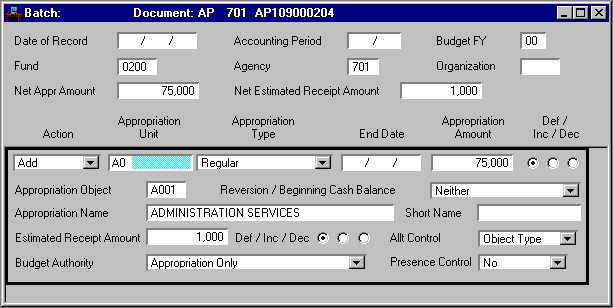
As part of the annual closing process, MARS will automatically calculate and roll forward any available budget/cash balances for Appropriation Type Special . The available balance is calculated at the end of the fiscal year and carried forward to the corresponding appropriation in the new fiscal year as an increase to the Beginning Cash Balance field. This is accomplished by generating appropriation transactions to update the appropriation table and post corresponding ledger entries. The available balance is computed by deducting total obligations from the appropriation authority plus either estimated or actual receipts, depending upon the appropriation Budget Authority Option .
If there is no corresponding new year appropriation, a new fiscal year appropriation account will be established and the Beginning Cash Balance field set accordingly. In this situation, the appropriation transaction will be generated with an Action of Add , for original entry. Otherwise, the Beginning Cash Balance field will be incremented by the calculated amount; i.e., the appropriation transaction will be generated with a Modify Action .
Appropriation transactions can be entered manually, if desired, to complement the annual close process and adjust the beginning cash balance amount to the desired value. For instance, prior to annual closing, the beginning cash balance may be set to $50 in the new year with an appropriation transaction. If annual closing calculates an available balance of $75 in the old year, annual closing will increment the beginning cash balance in the new year by $25, i.e., the difference.
The appropriation transactions which have been generated by the annual close process may also be manually altered after they have been loaded to the Document Suspense File by the system. In either case, the user may change amounts calculated by the annual close process when appropriate.
For all updates to the beginning cash balance, ledger entries will be posted to the ledger for the new fiscal and budget year with a budgetary offset to fund balance. These entries are identical to standard ledger entries for appropriation updates but employ account type 47 (Beginning Cash) so they may be distinguished for reporting purposes.
Some organizations require that beginning cash balances be established in the new year to allow spending prior to closing of the prior year. This is not a recommended procedure since the amount to carry forward is uncertain until the prior year has been closed and all accounting transactions posted. If necessary, however, this procedure may be supported by running the annual close process to generate new year budget/cash balances prior to running the full annual close process. If this is done, budget/cash balances will be calculated based on the most current available balances in the prior year. Note, however, that the system will not maintain consistency between years as a result of spending until the full annual close has been executed.
For instance, if an obligation is posted to the prior year after generating new year balances, the available balance in the old year will be reduced but the balance carried forward to the new year will remain unchanged. Once the full annual close is run, the appropriate balances to be carried forward will be recalculated and adjusted accordingly.
Appropriation reversions are coded on the Appropriation (AP) transaction. Reversions reduce the budget authority associated with an Appropriated Program. Reversions are entered on appropriations by selecting Reversion in the Reversion/Beginning Cash Balance field. The budgetary effect of a reversion is a reduction in budget authority without changing the current appropriation.
Deactivating/Reactivating Appropriations
An Appropriation Program may be deactivated to prevent further expenditure obligations against the appropriation. This can be a useful measure for implementing temporary spending freezes.
When a unit of appropriation is deactivated, any expenditure transactions containing the deactivated Appropriated Program code will be rejected. Deactivation and reactivation are achieved with appropriation transactions selecting the Deactivate Action on Appropriation (AP). The Status indicator column in the Appropriation Index (Extended) (EAPP) shows whether a Appropriation Unit code is active ( A ), or inactive ( I ).
Appropriation transaction amounts are subjected to the following tests:
- The following amounts must have a logical relationship:
- The original appropriation.
- The current appropriation amount .
- The difference between current and original appropriation amount is the increase or decrease amount .
- The following amounts must also have a logical relationship:
- The current estimated receipt.
- The original estimated receipt amount .
- The difference between current estimated and original estimated amount is the increase or decrease amount .
- On decrease modifications when Appropriation Control Option is Full for Fund (FUN2), the new budget authority cannot be less than the amount already obligated against the appropriation. (Budget authority is defined by the Budget Authority Option. the obligated amount is the sum of the Expended and Encumbered Amounts.)
Accounting Model and the Ledger
When a new Appropriation (AP) document with an appropriation amount is accepted by MARS, it is posted to the Budget Ledger in the following manner.
Dr Fund Balance (Budgetary accounts only)
Cr Appropriation (Budgetary accounts only)
The amount posted is the Increase/Decrease Appropriation Amount from the Appropriation (AP) transaction. Figure 27 illustrates the accounting model for appropriations.
Accounting Model for Appropriations
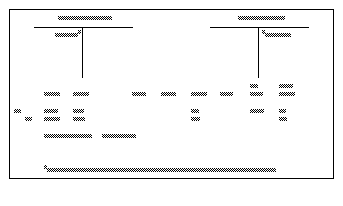
The individual appropriation budgets for each Fund, Agency, and Organization level appropriation are recorded in the Appropriation (EAP2) table. This system-maintained table captures all budgetary, expenditure, and receipt transactions that reflect activity against an appropriated program. This includes status information, appropriation budget amounts, estimated and actual receipts, related allotment and expense budget amounts, and pre-encumbered, encumbered and expended amounts against each appropriated program.
New appropriation lines are established in the appropriation table for new units of appropriation. On modify transactions, the appropriation budget fields are changed in the appropriate (existing) line. Accounting transactions relating to lines in the table also update fields in the table. Figure 28 is a sample of Appropriation Inquiry (Extended) (EAP2).
Appropriation Inquiry (Extended) (EAP2)
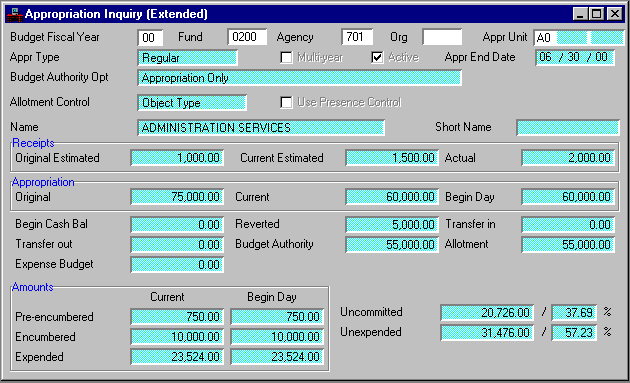
An explanation of the Appropriation Inquiry (Extended) (EAP2) presented in Figure 28 follows. Each numbered item below explains one aspect of the information provided in the window.
- This appropriation was for Budget Fiscal Year 2000. Since the fiscal year end is 06/30/00, and the Appropriation End Date is 06/30/00, the Multi-Year indicator is automatically not selected. The Appropriation Type is Regular , indicating a regular annual appropriation.
- The Original Appropriation when the budget was approved (Budget Approved Indicator on Fiscal Year (FSYR) selected) was $75,000.00.
- The appropriation has been reduced by $15,000 to the Current Appropriation of $60,000.)
- Since the appropriation is not a Special type, the Beginning Cash Balance will always be zero. For Special appropriations, uncommitted balances from prior years are carried forward and shown in this field.
- To prevent spending, $5000 was Reverted from this appropriation. A reversion reduces the spending authority (budget authority) without changing the approved or currently modified appropriation amount.
- The status of this appropriation is Active .
- The current Budget Authority (the amount available for obligating) is $55,000.00. It is calculated as follows:
Current Modified Amount 60,000.00
plus: Beginning Cash Balance 0.00
less: Reverted Amount (5,000.00)
- The Budget Authority Option has been set to Appropriation Only. No additional spending authority will result from revenues recognized against the appropriation.
- The Use Presence Control field is blank, meaning that this appropriation utilizes the appropriation control setting on the Fund (FUN2).
- Total Actual Receipts to date are $2000.00.
- The current outstanding purchase requisitions referencing this appropriation total $750.00.
- The current outstanding purchase orders referencing this appropriation total $10,000.00.
- The Current Expended Amount is $23,524.00. This total includes all payment vouchers, expenditure corrections and journal vouchers which reference this appropriation.
- The total allotments which reference this appropriation are $55,000. Note that total allotments cannot exceed the actual appropriation.
- The total of the expense budget lines which reference this appropriation is $0.00. No expense budgets have been established for this appropriated program. Note that total expense budgets can exceed the appropriation total. Once again, total expenditures, encumbrances and pre-encumbrances will not exceed the appropriation plus actual or estimated cash receipts (if Full Appropriation Control is selected).
- The current Uncommitted balance is $20,726.00, calculated as follows:
less: Pre-Encumbered: <750.00>
less: Expended Amount: <23,524.00>
Allotments (Allotment Programs)
Allotments establish spending ceilings for allotment programs for specified time periods. Allotment ceilings can be established for monthly, quarterly or yearly time periods.
Allotments provide a way to control or track obligations on a more frequent basis than is possible with the annual appropriation and expense budget amounts. They can be established to act as operational ceilings or warnings of obligation levels and used for decision making; alternately they can be used to flag areas where additional appropriations should be requested.
The options that control whether allotments are to be established, and if established, the degree of control they exert over spending, are on the Control Options view of Fund (FUN2). This allows each fund to operate under the type of allotment control as required for the purpose of that particular fund. See System Controls and Options for a complete discussion of options.
As described above, the primary level of budgetary control chosen for allotment programs is specified on Fund (FUN2). A secondary level of budgetary control can be specified for individual allotment programs that supersedes the Allotment Control option specified on FUN2. This secondary level allows for an allotment program to be established with Presence budgetary control even though the primary budgetary control is cumulative. The Use Presence Control option will allow specific allotment programs within a fund to be established with Presence Budgetary Control even though the fund is established with Cumulative Budgetary Control.
The steps necessary to implement the allotment capability are:
- Select, for each fund that is governed by allotments, Allotment Control Option Full , Presence, Cumulative or None, and record the choices on Fund (FUN2). (See System Controls and Options.)
- Decide on the funds for which allotments should be recorded, and record an Allotment Frequency for each in the Fund (FUN2).
- Process Appropriation (AP) transactions to create the appropriated program referenced on the allotment.
- Process Allotment (AL) transactions using the appropriated program created in the previous step and the associated allotment program. Funds with Allotment Full control require that an allotment exists in the allotment table and potential obligations must not exceed the allotment amount. Likewise, allotment lines, but not necessarily amounts, must be submitted for funds with Allotment Presence control before any expenditure transactions will be accepted against that fund. (Note: Expenditure documents are defined as requisitions, purchase orders, payment vouchers, manual warrants, payroll vouchers, and some journal vouchers.)
A field named Allotment Include Encumbrance is associated with a Fund on FUN2. This field is used to determine how unobligated budget balance is to be calculated for allotment programs with regards to encumbrances. Users have the option to select the Allotment Include Encumbrance field to either affirm or disaffirm the inclusion of encumbrances.
A Yes selection means that encumbrances will be added with expenditures when computing unobligated budget balance for the applicable allotment period. A No selection means that encumbrances will not be added with expenditure when computing unobligated budget balance for expenditure transactions. A five step allotment budget validation process will be used to process encumbrances greater than the available unobligated budget balance for a given allotment period. This process will not allow expenditures to exceed the available unobligated budget balance for a given allotment period.
- An expenditure accounting transaction is edited to determine if the expenditure amount is greater than the available unobligated allotment budget by allotment period. If the expenditure exceeds this budget, then an error will be returned and the transaction rejected.
- The total allotment budget for all periods will be computed.
- The total encumbrances for all periods will be computed.
- The Total expenditures for all periods will be computed.
- The total encumbrances (Step 3) and total expenditures (Step 4) will be added together. If this amount exceeds the total allotment budget (Step 2), then the transaction will be rejected and an error message will be issued.
In addition to the allotment budgetary control established by the Allotment control field on Fund (FUN2), the Allotment control field is used to provide an additional level of budget control for allotment programs. When an appropriation program is established by processing an Appropriation (AP) document, the Control Ind is selected to determine how allotment program budgets are controlled. Valid options for the Allotment are:
- Object Type. This means that budget availability for allotment programs is based on the object type hierarchy associated with an object account code. Thus, budget availability is based on Budget Fiscal Year, Fund, Agency, Organization, Appropriation Program, Allotment Program, Object Type and Allotment Period.
- Object Class . This means that budget availability for allotment programs is based on the object class hierarchy associated with an object account code. Thus, budget availability is based on Budget Fiscal Year, Fund, Agency, Organization, Appropriation Program, Allotment Program, Object Class, and Allotment Period.
- Neither . This means that budget availability for allotment programs is not based on either Object Type or Object Class. Thus, budget availability is based on Budget Fiscal Year, Fund, Agency, Organization, Appropriation Program, Allotment Program, and Allotment Period.
Allotment amounts are recorded in the system through the Allotment -- Extended (AL) transaction (shown in Figure 29). Modify transactions can increase or decrease previously recorded allotment amounts as long as the allotment period is still open. Modify transactions are the only manner by which allotment amounts can be changed. If Full Expenditure control is selected for allotments, the allotment for a period cannot be reduced below the total of existing pre-encumbrances, encumbrances and expenditures.
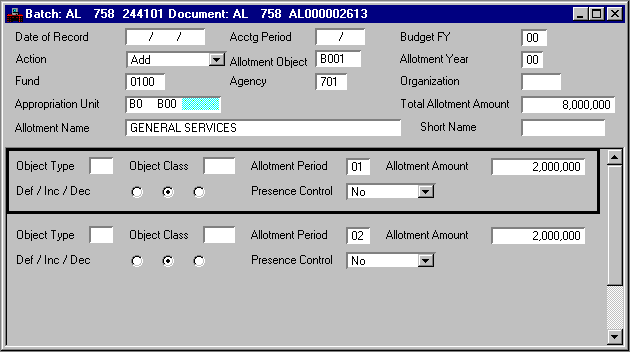
Allotment Programs are expressed in terms of allotment periods within an appropriated program. Allotment periods may be Yearly , Quarterly , or Monthly , and are established separately for each fund in the Allotment Frequency Control Option on Fund (FUN2). Recording allotment frequency on Fund (FUN2) ensures that all allotments applying to a specific fund are recorded in the same manner (for example, all allotments for fund 001 are monthly, even if the fund is governed by three different appropriations).
Valid values on Fund (FUN2) that govern Allotment Frequency are:
This means that there is one allotment period for all appropriations governing this fund. You represent this as 01.
This means that there are four allotment periods for all appropriations governing this fund. You represent these periods as:
- 01 (first fiscal quarter)
- 02 (second fiscal quarter)
- 03 (third fiscal quarter)
- 04 (fourth fiscal quarter)
Monthly or Accounting Period Allotments
This means that there are 14 allotment periods for all allotment programs associated with this fund. Monthly allotments may be desired when stringent controls are necessary on spending within a specific fund. Combined with allotment control, a monthly allotment frequency can enforce an evenly distributed spending policy over a year, or ensure that a specific amount remains unobligated until a particular accounting period. You represent these periods as:
- 01 - Represents first fiscal month
- 02 - Represents second fiscal month
- 03 - Represents third fiscal month
If allotments are monthly, the allotment period is open as long as the corresponding accounting period is open. A quarterly allotment is open until all three accounting periods in the allotment period are closed. Lastly, with yearly allotments the allotment period is open as long as the fiscal year is open.
You may decide to use allotment amounts as controls on spending. The option to use allotments for control is chosen individually for each fund, and the choice for each fund is recorded on Fund (FUN2), in the Allotment Control field or on the Allotment (AL) document in the Allotment Use Presence Control field. Valid values for the field are:
- Full . This means that total obligations against allotments within the fund cannot exceed the budgeted allotment amount. Therefore, you must enter allotment transactions for the fund, including valid amounts. Full control is reduced to presence control when the allotment has a negative budget amount.
- Presence . This means that the fund requires allotments, but amounts are not checked; therefore, you must enter allotment transactions for the fund, but amounts can be zero.
- None . This means that the fund does not use allotments; therefore, you cannot enter allotment transactions for the fund.
- Cumulative. Leftover unobligated amounts can be used in a future allotment period. Processors will perform allotment dollar edits against the cumulative allotment balance, considering the current and previous periods' allotment balance.
The Allotment Object provides the ability to differentiate allotment amounts for a variety of "types" of allotments, such as: Regular Allotments, Reorganization Allotments, and Salary Improvement Allotments. Allotment objects will be stored on Budget Object (BOBJ)). Allotment documents will validate that the Allotment Object code is stored on the BOBJ table. The AL document validates against the Budget Object Indicator to ensure that the code is an Allotment Object. If the Budget Object Indicator does not identify the Budget Object as an Allotment Object (AL), then the system will issue an error message and will not process the AL transaction.
The amounts allotted for a period apply only to one period. Unused allotments are available for reversion to the appropriation and are not automatically added to the allotment for the following period unless the cumulative allotment control option is selected.
- If there are four allotment periods for the allotment program called general administration, the government may specify that its Department of Accounting may spend no more than 40% of this appropriation during the first 3 months of the fiscal year, no more than 20% during the second 3 months of the fiscal year, etc. If only 30% of the appropriation is spent during the first quarter, allotment full control will still limit the spending in the second quarter to 20%. Modify transactions must be submitted if you want to carry over the unused amounts. (Subtract the unused amount from the first allotment period and add it to the following period.)
Relationship of Allotment Programs to Appropriation Programs
Allotment Programs provide the capability to divide an Appropriation Program across smaller accounting periods for control purposes. Each appropriation program may have one or more allotment programs, which may be divided into one to thirteen allotment periods (identified by the allotment period).
If the accounting period is 04 and allotments are quarterly, the appropriate allotment period is 02 (the fourth accounting period is in the second fiscal quarter). Comparisons for allotment control are carried out the same way as for appropriations.
For Continuing appropriations, allotments must be established for each fiscal year affected. Similarly for non-continuing appropriations with encumbrances rolled into future years, allotment periods must be defined to the future years affected for presence control.
Allotment amounts are not necessary unless excess expenditures will be posted. As an example, if a $100 encumbrance posted in the fourth quarter of one year is liquidated in the first quarter of the next year, with a $100 expenditure, an allotment period 01 must be defined for the next year to be referenced by the expenditure. However, since both an encumbrance reversal and an expenditure will be posted, which offset each other (the net amount being zero), the allotment can be zero in the new year.
Allotments and Accounting Transactions
As described above, allotments are defined by Budget Fiscal Year, Fund, Agency, Organization, Appropriation Program, Allotment Program, Object Type, Object Class, and Period. On accounting transactions, these dates and codes are either entered directly or inferred.
Budget Fiscal Year is generally inferred from the transaction date or prior document reference. If there is no prior document reference and the Budget Fiscal Year is entered on the transaction, the coded year will be used.
At a minimum, fund, agency, organization, program budget unit, and object are directly coded on accounting transactions. The correct allotment Organization (if Organization is required) will be inferred from the Allotment Organization field on Organization (ORG2).
Allotment period is not entered on accounting transactions and is inferred from the accounting period.
Allotment transaction amounts are subjected to the following tests:
- If Allotment Control is Full for the fund, the new allotment amount cannot be less than the amount already obligated against the allotment. (Obligated amount is the sum of the expended and encumbered amounts from the allotment table).
- The sum of all allotment programs in an appropriated program cannot be greater than the budget authority amount.
Accounting Model and the Ledger
Allotment transactions generate memo entries that are used strictly for reporting purposes and do not impact any of the accounting ledgers. When an allotment transaction is processed the following one sided memo entry is posted to the Allotment Ledger:
Dr Allotments (budgetary accounts only)
The dollar amount used is the increase/decrease amount recorded on the transaction. Figure 30 illustrates the accounting model for quarterly allotments.
Accounting Model for Allotments
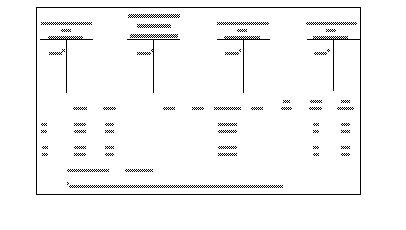
New lines are established in the allotment table for each allotment period. In modify transactions, data elements are changed in the appropriate (existing) line. Expenditure transactions relating to allotment lines also update entries in the table.
Figure 31 shows an example of an inquiry to Allotment Inquiry (Extended) (EALL). The relationship among the various fields on Allotment Inquiry (Extended) (EALL) is detailed below.
Allotment Inquiry (Extended) (EALL)

- The allotment Period is derived by combining the budget fiscal year with the allotment period.
- The Pre-Encumbered, Encumbered, and Expended Amounts are displayed for each allotment period. The pre-encumbrance and encumbrance amounts reflect updates for only the related allotment period. For example, if a pre-encumbrance is created in period 01 and liquidated in period 02, an increase will be posted to period 01 and a decrease to period 02; the period 01 pre-encumbrance will be left as outstanding. Expenditures will be posted in the allotment periods they occur.
- The current allotment period is 991. The Allotment Period field is a five-character field which can be broken down as follows:
|
Fiscal quarter (displayed for monthly or quarterly allotments only) |
|
The expense budget transaction records and maintains the expense budget for the current and future budget fiscal years. Prior year budgets, the current year's budget and several future years' budgets can be maintained simultaneously in MARS.
Expense budget transactions are used to initially establish the spending side of a budget and to modify this budget, as necessary. Each budget line represents an object of expenditure (goods or services). These lines are organized within fund/agency combinations.
Expense Budget lines are related to appropriated programs, allotment programs, and program budget units. The Appropriation Unit (i.e. appropriation program, allotment program, and program budget unit) is one of the line-level codes on the expense budget transaction. Usually, the total of line amounts from expense budget lines containing a particular Appropriation Unit code will equal that appropriation's budget authority. However, this relationship does not have to exist.
For the majority of Object codes the amount budgeted is a positive amount. However, expense budget lines for reimbursable Object codes could have a negative budget amount.
Expense budgets are stored in a system-maintained Expense Budget Inquiry (Extended) (EEX2) table, on a line item basis. An audit trail of budget modifications is available from the Budget Ledger.
You can also look at the current state of the year's expense budget, including total obligations, in various detailed and summary levels through a series of standard reports.
Implementing an Expense Budget
The steps necessary to implement the expense budget capability are:
- Decide, for each fund, whether to institute Expense Budget control on Fund (FUN2) as Full , Presence , or None . (See System Controls and Options for more information.)
- Decide whether to have the system issue a warning message each time an Expense Budget (EB) or Revenue Budget (RB) is processed. The purpose of the message is to alert the user that this transaction could potentially put a fund out of balance from a budgetary perspective. This message is issued if the "RBEB" entry on Application Dates (LDAT) contains a Y in the first byte of the Miscellaneous Parameter . This is a system-wide flag.
- Decide, for each fund/agency combination, whether expense budgeting is to be done by Organization, by Activity, by Function, by all three, or by none of the three. Record these choices in the Fund Agency (FGY2). (See System Controls and Options for more information.)
- Establish Organization , Appropriation Program, Allotment Program, Program Budget Unit, Activity , Function , and Object in relevant master tables.
- Submit expense budget transactions to establish budget lines. Budget amounts are not required, except on lines for funds with full control.
- When the budget as recorded in the system is accepted by legislative authority, set the Budget Approved Indicator to Y in Fiscal Year (FSYR). The Budget Approved Indicator also applies to the revenue budget, so coordination with the revenue budget preparation office is recommended.
Lines are added to Expense Budget Inquiry (Extended) (EEX2) in two ways:
- Through the processing of the Expense Budget (EB) document.
- Through the processing of expenditure accounting transactions (occurs only when the Expense Budget Control Option for the fund involved is None on Fund (FUN2)). MARS creates the budget lines "on the fly" according to expenditures actually made. This lets summary obligation balances be maintained even when the budgeting facility is not used. This means that entities (or agencies within entities) not using the budgeting capabilities will still have lines in the expense budget table recording expenditure accounting transactions in summary form.
Expense Budgets and Expenditure Accounting
Expense budget lines are associated with expenditure transactions based upon their accounting distributions. An expenditure matches a budget line when all codes on the budget line exist in the expenditure transaction. However, the expenditure line may be in more detail (have more codes) than the budget line and still match.
When a match occurs, the budget line's Pre-Encumbered , Encumbered , and/or Expended amounts, whichever are appropriate, are adjusted in the expense budget table by the amount of the accounting transaction. For example, a new purchase order increases the encumbered amount on its matching budget line. If the purchase order references a requisition, the pre-encumbered amount is also reversed. A decrease adjustment to a previously entered purchase order causes a decrease to the encumbered amount.
Options Affecting Expense Budget Documents
You may decide to use expense budget amounts as controls on spending. When this option is used, MARS rejects any accounting transaction that would cause the total obligated amount to exceed the current modified budgeted amount for that budget line.
The option to use the expense budget as a spending control is chosen individually for each fund. The choices, which may affect the transactions you enter on expense budget documents, are recorded on Fund (FUN2), in the Expense Budget Control Option field. Valid values for this field are:
- Full . This means that total obligations against the fund cannot exceed the budgeted amounts; therefore, you must enter expense budget transactions for the fund, including valid amounts. Full control is reduced to presence control when the expense budget line has a negative budget amount.
- Presence . This means that the fund requires an expense budget, but the budget amount may be exceeded; therefore, you must enter expense budget transactions for the fund, but amounts can be zero.
- None . This means that expense budgets are not used for the fund. MARS will, however, automatically generate expense budget lines from expenditure transactions processed by the system, and track expenditure activity against those lines.
You can implement a fourth expense budget control option when you enter the expense budget transactions. When you are budgeting for funds that have presence control, you can override the presence control and implement full control for individual budget lines. For example, you may want to implement full control on travel expenses within a fund that only has presence control. This option is chosen with the Spending Control indicator field on the expense budget (EB).
- The default None expense budget control in MARS needs to be raised to restrict cellular telephone charges to a specific budgeted amount. The organization can restrict spending on a line-by-line basis by using the Spending Control indicator on all budget lines concerning cellular telephone charges. Figure 31 shows how to enter the s expense budget to accomplish this. Set the Spending Control indicator to Yes to impose full control on those lines in which it appears.
- Figure 32
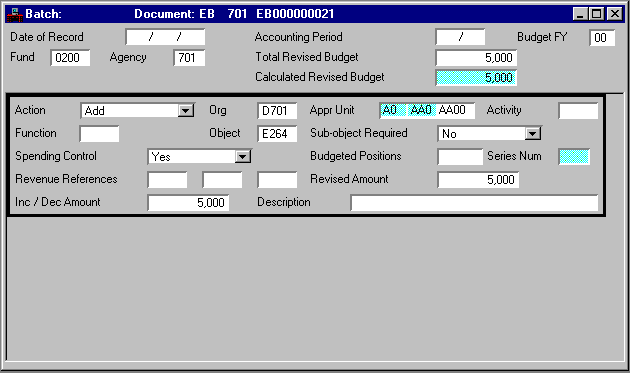
Expense Budget (EB) Sub-Object Option
The Sub-Object Required option is chosen on a line by line basis on the Expense Budget (EB) document. If this field is Yes , all expenditure accounting transactions against the budget line must include a valid Sub-Object code. This option can enforce detail reporting for specific budget lines.
Expense Budget (EB) Organization Option
This option controls whether each fund/agency budgets expenditures by Organization. The choice made for each fund/agency is recorded on Fund Agency (FGY2). Valid values are:
- Required on Budget and Accounting . Requires an Organization on Expense Budget (EB) and accounting transactions for the fund/agency.
- Required on Accounting . Indicates that Organization is required on accounting transactions but must not be coded on Expense Budget (EB) documents for the fund/agency.
- Optional on Accounting . Indicates that Organization must not be coded on Expense Budget (EB) for the fund/agency. However, Organization is optionally coded on accounting transactions.
Expense Budget (EB) Activity Option
This option controls whether each fund/agency budgets expenditures by Activity. The choice made for each fund/agency is recorded on Fund Agency (FGY2). Valid values for this option are:
- Required on Budget and Accounting . Requires Activity on Expense Budget (EB) and accounting transactions for the fund/agency.
- Required on Accounting . Indicates that Activity is required on accounting transactions but must not be coded on Expense Budget (EB) for the fund/agency.
- Optional on Accounting . Indicates that Activity must not be coded on Expense Budget (EB) for the fund/agency. However, activity is optionally coded on accounting transactions.
Expense Budget (EB) Function Option
This option controls whether each fund/agency budgets expenditures by function. The choice made for each fund/agency is recorded on Fund Agency (FGY2). Valid values for this option are:
- Required on Budget and Accounting . Indicates that Function on Expense Budget (EB) and accounting transactions for the fund/agency is required.
- Required on Accounting . Indicates that Function is required on accounting transactions but must not be coded on Expense Budget (EB) for the fund/agency.
- Optional on Accounting . Indicates that Function must not be coded on Expense Budget (EB) for the fund/agency. However, function is optionally coded on accounting transactions.
Deactivating/Reactivating Expense Budgets (EB)
An Expense Budget (EB) line may be deactivated, which will prevent any additional obligations against the line (when Expense Budget control on FUND (FUN2) is Full or Presence ). This is a useful measure for implementing temporary spending freezes.
When an expense budget line is deactivated, any expenditure transactions relating to the line will be rejected. Also, deactivated lines will not appear on subsequent expense budget turnaround reports. A line can be reactivated at any time.
Deactivation and reactivation are achieved with expense budget transactions. The Expense Budget Line Active indicator on Expense Budget Index (Extended) (EEXP) shows whether a line is active or inactive.
Clearing Inactive Budget Lines
A special clearing program, Clearing Inactive Budgets (MCBC), can be run at any time during the budget fiscal year to clear your budget tables of unwanted (inactive) budget lines. The program also clears the budget ledgers of all records related to the deleted table entries.
The following criteria must be met for a line to be deleted from the expense budget table:
- The line status must be I for inactive.
- The following amount fields on the line must be zero:
- Modified Budget amount
- Pre-Encumbered amount
- Encumbered amount
- Expended amount
- The Budget Fiscal Year must match the budget fiscal year supplied as a parameter in Application Dates (LDAT).
All lines in the Current Detail Budget Ledger and the Year-to-Date Budget Ledger that match the deleted table (EEX2 or REV2) entries will be deleted from the ledgers.
To execute this program, ask your system administrator to run the Clearing Inactive Budgets (MCBC) process. See the System Administration Guide for the parameters required for this program.
Logic Tests on Expense Budget Amounts
Expense budget transaction amounts are subjected to the following tests:
- The following three amounts must have a logical relationship:
- The Current Approved Budget Amount
- The Current Modified Budgeted Amount
- The difference between the Current Approved and Current Modified Budget Amount is the increase or decrease amount
- On decrease modifications when the Expense Budget Control Option is Full for the fund, the revised budgeted amount may not be less than the amount already obligated against the expense budget line. (The obligated amount is the sum of the expended and encumbered amounts).
Accounting Model and the Ledger
New expense budget lines are posted to the Budget Ledger in the following way:
Cr Budgeted Obligations (Budgetary accounts only) (increase EB line)
The amount posted is the Increase/Decrease Amount from Expense Budget (EB) document. Figure 33 illustrates the accounting model for expense budget transactions.
Accounting Model for Expense Budgets
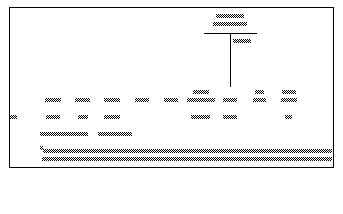
New lines are established in the expense budget (EEX2) table when new lines coded on expense budget (EB) transactions are accepted or when expenditure accounting lines are accepted by the system and the Expense Budget Control Option is None . On modify transactions, data elements are changed in the appropriate (existing) line. Expenditure transactions relating to lines in the table update the obligation data. By definition, (Expenditure transactions are requisitions, purchase orders, payment vouchers, manual warrants, payroll vouchers, and some journal vouchers.)
For field descriptions and samples of the windows, see the User's Reference .
The revenue budget facility records and maintains expected revenues for an entire budget fiscal year. Prior year budgets, the current year's budget and several future years' budgets can be maintained simultaneously.
Revenue Budget (RB) transactions initially set up the revenue (estimated receipt) side of a budget and modify this budget, as necessary. Each budget line represents a source of revenue expected to be received. These lines are organized within fund/agency combinations; that is, all lines specifying amounts to be received by one fund/agency may be entered on the same window and will appear together in reports. The results of revenue budget transactions are maintained in the revenue budget table. An audit trail of budget modifications is available from the Budget Ledger.
Figure 34 is a sample Revenue Budget (RB) document, coded to revise a revenue budget for fund 0200, agency 701.
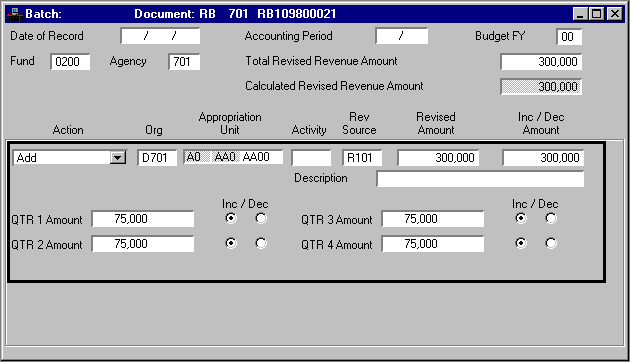
The steps necessary to implement the revenue budget capability are:
- Decide, for each fund, whether to institute Revenue Budget Presence control or None on Fund (FUN2). (See System Controls and Options for more information.)
- Decide whether to have the system issue a warning message each time an Expense Budget (EB) or Revenue Budget (RB) is processed. The purpose of the message is to alert the user that this transaction could potentially put a fund out of balance from a budgetary perspective. This message is issued if the "RBEB" entry on Application Dates (LDAT) contains a Y in the first byte of the Miscellaneous Parameter . This is a system-wide flag.
- Decide, for each fund/agency, whether revenue budgeting is to be prepared by Activity, by Organization, by both, or by neither. Record these choices on Fund Agency (FGY2). (See System Controls and Options for more information.)
- Establish Activity , Organization , and Revenue source codes in relevant windows.
- Submit Revenue Budget (RB) transactions to establish budget lines. Budget amounts are not required.
- When the budget as recorded in the system is accepted by legislative authority, set the Budget Approved Indicator to Y in Fiscal Year (FSYR). The Budget Approved Indicator also applies to the revenue budget, so coordination with the revenue budget preparation office is recommended.
Lines are added to Revenue Budget Inquiry (REV2) in two ways:
- By processing revenue budget transactions.
- By processing revenue accounting transactions. This only occurs when the Revenue Budget Control Option (on Fund (FUN2)) is None . MARS creates the revenue budget table lines "on the fly" according to revenues actually received. This permits a summary recognized amount to be maintained even when the revenue budgeting facility is not used. This means that funds not using the budgeting capability will still have lines in the revenue budget table.
Revenue Budgets and Accounting Documents
Revenue budget lines are associated with revenue accounting transactions through their accounting distributions. A revenue transaction matches a budget line when all codes on the budget line exist in the accounting transaction. However, the revenue accounting entry may be in more detail (have more codes) than the budget line and still match. For example, the revenue accounting transaction may contain an Activity code when the Revenue Budget Activity option (on Fund Agency (FGY2)) is set to Required on Accounting . Because the option is set to Required on Accounting , the revenue budget would contain spaces in the activity code.
When a match occurs, the budget line's recognized amount is adjusted appropriately. For example, a new cash receipt document increases the recognized amount on its matching line, unless the cash receipt references an invoice transaction. In that case, the amount has already been recognized, and nothing is changed on the revenue budget line. Modifications to previously entered transactions are also reflected in the recognized amount.
MARS requires that an Appropriation Unit is associated with each Revenue Budget (RB) line. An Appropriation Unit is comprised of an Appropriated Program, an Allotment Program, and a Program Budget Unit. The Appropriation Unit identifies a revenue budget line as an expected revenue for an Appropriated Program, an Allotment Program, and a Program Budget Unit. Actual revenues received against a given revenue budget line will be recorded as receipts against the Appropriation Unit. The Actual Receipts amount for the appropriation program is updated in the Appropriation Inquiry (Extended) (EAP2) table as receipts are recorded;.
When a Revenue Budget (RB) transaction is processed, a Program Budget Unit is coded in the Appropriation Unit field and the associated Appropriated Program and Allotment Program are inferred from the Program Reference Table (PRFT).
Accounting transactions which post against a given revenue budget line can update the Revenue Budget Inquiry (REV2) table with the following data elements:
- Budget Fiscal Year
- Fund
- Agency
- Organization (optional)
- Appropriation Unit (Appropriation Program, Allotment Program, and Program Budget Unit)
- Activity (optional); and
- Revenue Source
In addition to tracking revenue budgets by budget fiscal year, revenue estimates may be tracked by quarters. To establish quarterly revenue budget estimates, the quarterly amounts field must be populated on the Revenue Budget (RB) transaction. The following conditions must also exist to establish quarterly revenue estimates:
- The Header Total Revised Revenue Amount must equal the sum of each Line Revised Amount .
- The Line Revised Amount must equal the revised amount for each revenue budget line.
- The Line Quarter Amount is the amount of adjustment of revenue budget for each quarter.
- The Line Increase/Decrease Amount must equal the sum of Quarter Amount 1-4 , if quarters are specified.
Quarterly revenue estimates are not established if the Quarter Amounts field are blank on the Revenue Budget (RB) transaction. Changes in revenue budget are reflected on Revenue Budget Inquiry (REV2). However, quarterly revenue budget data is not displayed on REV2.
In MARS, the Current Detail Budget Ledger (CURRBD) posts ledger entries by quarter when specified, in addition to the accounting distribution. The Revenue Budget transaction will write up to four debit lines and four credit lines depending upon the number of quarters with dollar amounts. Ledger entries are not written for quarters for which the dollar amount equals zero.
Options Affecting Revenue Budgets
You may decide to use revenue budget lines to control acceptance of revenues. When this option is used, it means that before a revenue transaction (e.g. invoice or cash receipt) can be recorded in the General Ledger, it must match a line in the revenue budget.
Revenue budget lines never have to have amounts recorded in the system for processing, but amounts obviously make the budget and related reports more meaningful.
The option of whether or not to use the revenue budget as a control is chosen individually for each fund in your system. The choices, which may affect the way you enter revenue budget transactions, are recorded on Fund (FUN2) under Revenue Budget Control Option. The values recorded there are either:
- Presence . Indicates that revenue transactions against this fund require a revenue budget line; therefore, you must enter revenue budget transactions for this fund.
- None . Indicates that revenue budgets are not used for this fund. MARS will, however, automatically create revenue budget lines "on the fly" based on revenue transactions and track revenues against those lines.
Revenue Budget Organization Option
This option controls whether each fund/agency budgets revenues by Organization. The choice made for each fund/agency is recorded on Fund Agency (FGY2). The values recorded there are either:
- Required on Budget and Accounting . This requires that Organization be coded on revenue budget and accounting transactions for the fund/agency.
- Required on Accounting. This precludes Organization from being coded on revenue budget lines for the fund/agency, but make it required coding on accounting transactions.
- Optional on Accounting . This indicates that Organization must not be coded on the Revenue Budget (RB) document for the fund/agency. However, Organization is optionally coded on accounting transaction.
Revenue Budget Activity Option
The Revenue Budget Activity Option controls whether each fund/agency budgets revenues by Activity. The choice made for each fund/agency is recorded on Fund Agency (FGY2). The valid values are:
- Required on Budget and Accounting . This requires that Activity be coded on revenue budget and accounting transactions for the fund/agency.
- Required on Accounting. This precludes Activity from being coded on revenue budget lines for the fund/agency, but make it required coding on accounting transactions.
- Optional on Accounting . This indicates Activity must not be coded on the Revenue Budget (RB) document for the fund/agency. However, activity is optionally coded on accounting transaction.
Deactivating/Reactivating Revenue Budgets
A revenue budget line may be deactivated at any time. Deactivation prevents any further recognitions or collections against the line (when revenue budget presence control is in effect). All subsequent accounting transactions relating to inactive lines are rejected. A line can be reactivated at any time.
Deactivation and reactivation are achieved with revenue budget transactions. The Revenue Budget Line Active option on the Revenue Budget Index (REVB) shows whether a line is active or inactive.
Clearing Inactive Budget Lines
A special clearing program can be run at any time during the budget fiscal year to clear your budget tables of unwanted (inactive) budget lines. The program also clears the budget ledgers of all records related to the deleted table entries. The following criteria must be met for a line to be deleted from the revenue budget table:
- The Revenue Budget Line Active must be specified as inactive.
- The following amount fields on the line must be zero:
- Current Modified Budget
- Recognized
- The Budget Fiscal Year must match the one in Application Dates (LDAT)
All lines in the Current Detail Budget Ledger and the Year-to-Date Budget Ledger that match the deleted table (EEX2 and REV2) entries will be deleted from the ledgers. After this program is run, the balancing entries for the deleted lines in the Current Budget Ledger will still exist in the ledger (they will all net to zero). These records will disappear at month-end, when the detail lines in the Current Budget Ledger are summarized into the Year-to-Date Budget Ledger.
Ask your system administrator to run Clearing Inactive Budgets (MCBC). See the System Administration Guide for the parameters required for this program.
Logic Tests on Revenue Budget Amounts
Revenue budget transaction amounts are subjected to the following criteria:
- The following three amounts must have a logical relationship:
- The Current Approved Budget amount.
- The Current Modified Budget amount.
- The difference between the Current Approved and Current Modified Budget amount is the increase or decrease amount.
Accounting Model and the Ledger
New revenue budget lines are posted to the Budget Ledger in the following way:
Dr Estimated Revenue (budgetary accounts only)
Cr Fund Balance (budgetary accounts only)
The amount posted is the Increase/Decrease amount from the revenue budget transaction. Figure 35 illustrates the accounting model for revenue budget transactions.
Accounting Model for Revenue Budgets
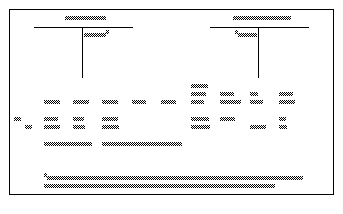
New lines are established on Revenue Budget Inquiry (REV2) when new revenue budget (RB) transactions are accepted or when revenue accounting lines are accepted by the system and the Revenue Budget option is None . On transactions, fields are changed in the appropriate (existing) line. Revenue transactions relating to lines in the table update the recognized amount and other fields. Figure 36 is an example of an inquiry to Revenue Budget Inquiry (REV2).
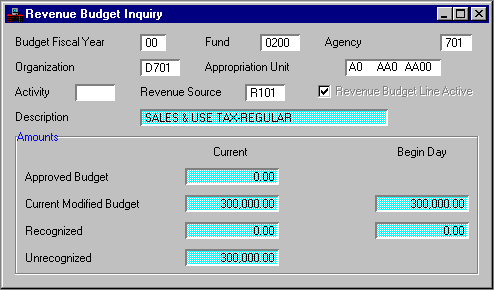
An internal accounting transaction occurs when one internal entity purchases goods or services from another internal entity. Usually, you do not know whether a purchase is going to be internal or from an outside vendor when the budget is being developed. You simply budget for the expense, and then when the purchase is actually made, it can be recorded as internal in the accounting transactions (the requisition, purchase order, and payment voucher). The obligation will be applied against the same budget line, whether it is internal or not.
If strict internal budgeting and control is desired, it can be implemented by establishing separate budget lines for internal purchases using: 1). Separate Object and Revenue source codes for internal lines; or 2). Separate Organization codes set up as lower levels in the organization reporting hierarchy.